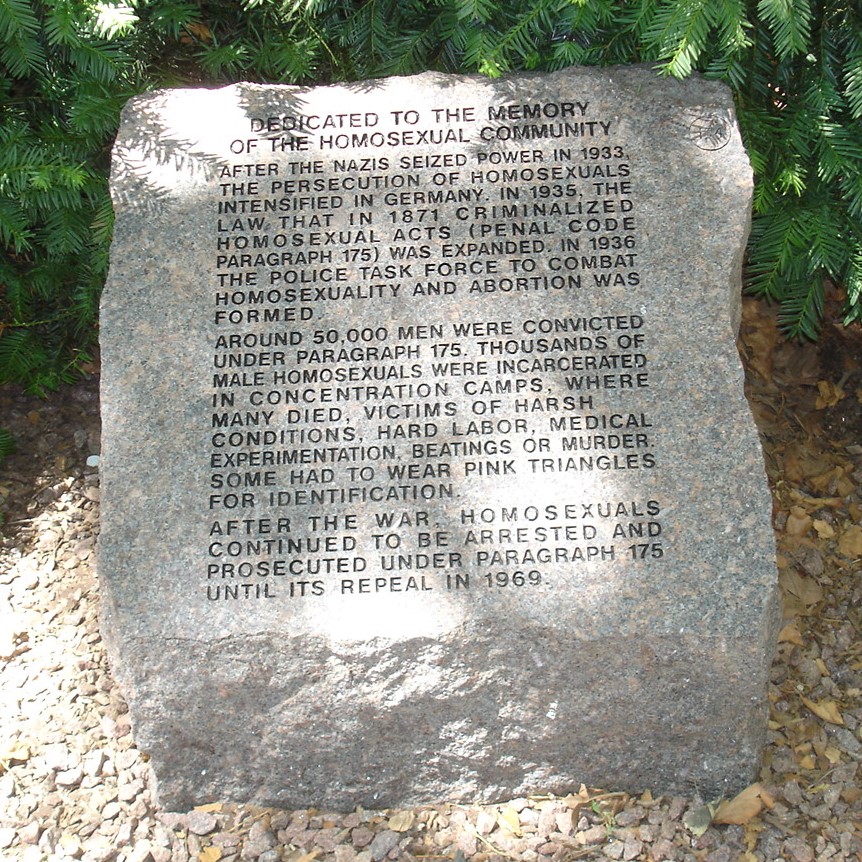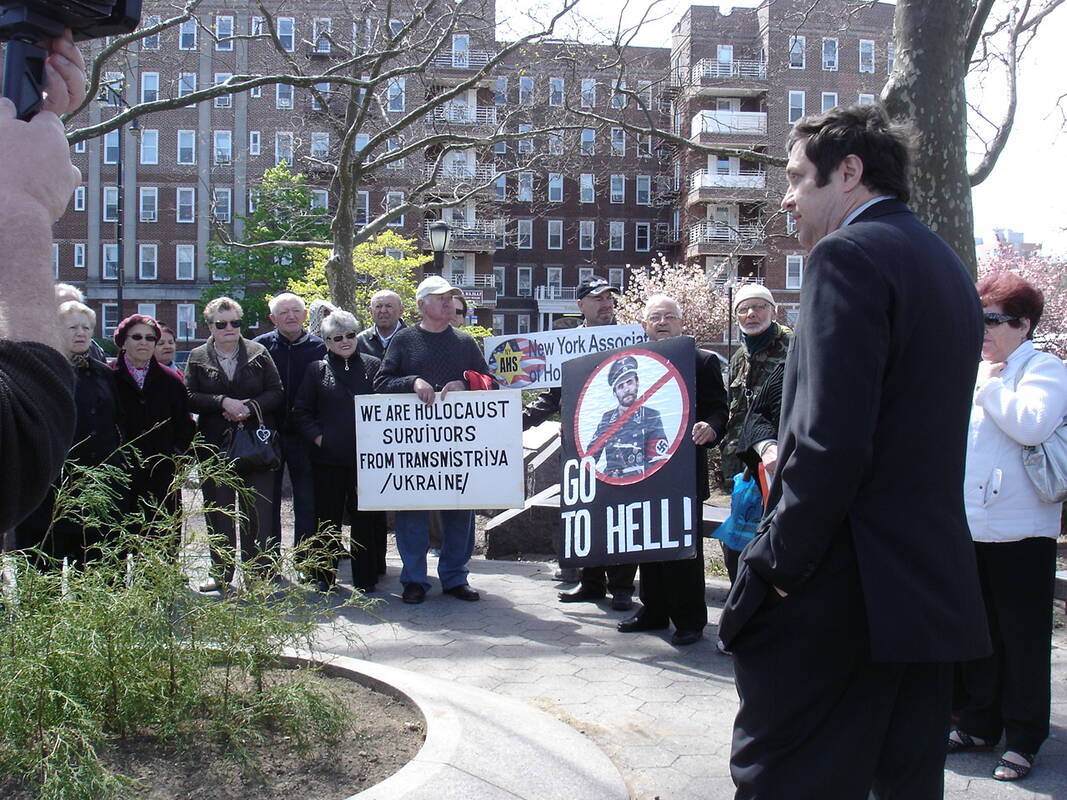
Holocaust Memorial Park
overview
In 1997, a permanent memorial to the approximately 6 million Jews systematically murdered by the Nazis and the roughly 5 million non-Jewish victims was unveiled in Holocaust Memorial Park at the edge of Sheepshead Bay, Brooklyn.
Original plans to include separate markers for specific groups of victims, including a homosexual community marker and another mentioning the fate of lesbians, were scrapped, leading to a multi-year advocacy effort by the International Association of Lesbian and Gay Children of Holocaust Survivors and Congregation Beit Simchat Torah to successfully have the markers inscribed in 2012.
History
In June 1985, city-owned land in Brooklyn – home to the largest Jewish population in the country and to many Holocaust survivors – was designated Holocaust Memorial Park. Construction of a permanent memorial for the park, located at the edge of Sheepshead Bay, began in 1994.
An eternal flame on top of a truncated steel tower was designed by George Vellonakis of the NYC Department of Parks and Recreation. A slab in front of the tower includes text remembering the approximately six million Jews who were systematically murdered by the Nazis and the roughly five million other victims, including “Homosexuals and others deemed ‘anti-social.’” As part of the original design concept approved by the City’s Arts Commission, 10 of about 40 granite markers surrounding the tower were reserved for the “Other Victims” so that their fates could be given historical context. However, this proposal was rejected by the Holocaust Memorial Committee, the local non-profit overseeing the park’s content, and Brooklyn Borough President Howard Golden, who had allocated funds for the memorial’s construction. Both argued that their fates were already mentioned on the slab at the tower’s base.
In response, Manhattan resident Rick Landman and Rabbi Sharon Kleinbaum of Congregation Beit Simchat Torah filed an unsuccessful request in 1996 to have five granite markers inscribed for the Other Victims. (Landman, a lawyer and gay rights activist, was co-chair of the International Association of Lesbian and Gay Children of Holocaust Survivors, established in 1991; Rabbi Kleinbaum was on the advisory committee to the United States Holocaust Memorial Museum in Washington, D.C.) These markers were to represent the homosexual community; political prisoners and “asocials” (with text mentioning lesbians); the disabled community; the Gypsy, Roma, and Sinti community; and Jehovah’s Witnesses. The following year, without these markers, New York City’s first public memorial to the Holocaust was dedicated on June 22, 1997.
The Holocaust Memorial Committee continued to deny the request for these five markers every year it was filed through 2009, when Landman’s group asked the City of New York for an appeals process. Barry Litchy, vice president of the committee, accused city officials of taking control of the park away from the Jewish community (even though the park was city owned). Assemblyman Dov Hikind, whose mother survived the Holocaust and whose constituents included many Orthodox Jews and Holocaust survivors, also voiced his opposition, calling the Holocaust “a uniquely Jewish event.” Michael Berenbaum, of the U.S. Holocaust Memorial Museum, countered that including non-Jewish victims had long been accepted practice at institutions around the world. According to a 2009 article in the Forward, he noted that, “In order to understand what is unique about the victimization of the Jews, you must understand where their fate paralleled and where their fate differed from other Nazi victims.”
A blue-ribbon panel consisting of representatives from various Holocaust museums reviewed and approved the application. In 2010, it was given final approval from the parks commissioner and the mayor. Demonstrations in opposition were made from a segment of the Orthodox community.
On July 25, 2012, the five markers were inscribed. Landman, the gay American-born son of German Jewish refugees whose family lost 17 people to the Holocaust, said on that day,
The full extent of the Nazi atrocities can only be seen by viewing how their ideology of dehumanizing and killing many others furthered their ability to try to exterminate all the Jews. First they killed or arrested political opponents, the disabled and homosexuals etc. years before they perfected their Final Solution.
The following year, on Sunday, May 5, 2013, an intimate unveiling ceremony was held for all five markers, with representatives from each community. Members of Congregation Beit Simchat Torah and the Lambda Independent Democrats of Brooklyn unveiled the homosexual community marker. They were joined by representatives from the International Association of Lesbian and Gay Children of Holocaust Survivors and the Church of the Holy Apostles Soup Kitchen.
The marker reads:
“Dedicated to the Memory of the Homosexual Community
After the Nazis seized power in 1933, the persecution of homosexuals intensified in Germany. In 1935, the law that in 1871 criminalized homosexual acts (penal code Paragraph 175) was expanded. In 1936 the police task force to combat homosexuality and abortion was formed.
Around 50,000 men were convicted under Paragraph 175. Thousands of male homosexuals were incarcerated in concentration camps, where many died, victims of harsh conditions, hard labor, medical experimentation, beatings or murder. Some had to wear pink triangles for identification.
After the war, homosexuals continued to be arrested and prosecuted under Paragraph 175 until its repeal in 1969.”
The fate of lesbians is included in the political prisoners and “asocials” marker: “Lesbians, alcoholics, homeless people and others were deemed “asocials” and were forced to wear black triangles in the concentration camps. They were subjected to forced manual labor, justified by the Nazis as “reeducation” to instill proper social habits and personal discipline.”
Entry by Amanda Davis, project manager (December 2024).
NOTE: Names above in bold indicate LGBT people.
Building Information
- Architect or Builder: George Vellonakis (memorial design)
- Year Built: 1994-97
Sources
Adam Dickter, “Gay Holocaust Recognition Eyed,” The New York Jewish Week, January 17, 2003, 10.
Alex Weisler, “Whose Holocaust?” Forward, June 19, 2009, 3. [source of Berenbaum quote]
Bill Egbert, “Off Mark on Holocaust Park,” Daily News, June 8, 2009, 34. [source of Hikind quote]
Courier Life, “Changes to Holocaust Park,” New York Post, May 14, 2009, bit.ly/4i20rWD.
The Holocaust Memorial Committee, bit.ly/3OmiWru.
Holocaust Memorial Park, NYC Department of Parks and Recreation, bit.ly/3OnwKSE.
Rick Landman, “Other Victims Markers at the Sheepshead Bay Holocaust Memorial Park, Brooklyn, NY,” InfoTrue, bit.ly/4g0doP1. [source of pull quote]
Rick Landman, NYC LGBT Historic Sites Project Site Suggestion Form, 2023, 2024.
Somini Sengupta, “A Rift Opens Over ‘Other Victims’ at Holocaust Memorial,” The New York Times, August 18, 1996, CY10.
Do you have more information about this site?
This project is enriched by your participation! Do you have your own images of this site? Or a story to share? Would you like to suggest a different historic site?








